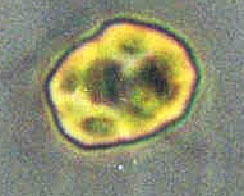Raphidophytes
(Chattonella, Fibrocapsa, Heterosigma)
Delaware’s coastal bays and a portion of Maryland’s are frequented by several raphidophyte species (~10 um bi-flagellated cells) that can yield fish mortalities or low dissolved oxygen events. These are usually observed in upper tributaries or the small nutrient-rich, long-residence time canals of the coastal bays, often summarized by Delaware’s Citizen Monitoring Program (http://citizen-monitoring.udel.edu/).
 Chloromorum toxicum
Chloromorum toxicum
Chloromorum toxicum (aka Chattonella cf. verruculosa) and C. subsalsa are two species that can produce brevetoxins (causes Neurotoxic Shellfish Poisoning). Brevetoxin is also produced by Karenia brevis, a species associated with FL red tides, fish kills/sea mammal deaths. Exposure to brevetoxins can cause itchy skin, runny nose, watery eyes, wheezing, and, in some cases, serious asthma attacks. C. toxicum has been associated with large fish kills in other areas, and was implicated in a fish kill event in Del during 2000. No evidence of toxic activity in MD.
Fibrocapsa
Fibrocapsa has had devastating impacts on mariculture operations in Japan. Strains of F. japonica from the North Sea in Europe have been capable of producing a toxin that killed fish in laboratory studies. Two seals that died in the Wadden Sea in Germany were found to have high levels of the toxin fibrocapsin. North Sea strains of F. japonica grow well at 11-25oC, 20-30 salinity. While found in the Chesapeake Bay it has never bloomed there.
Heterosigma
Heterosigma is more wide spread. H. akashiwo is found on both coasts of the US and is considered the causative organism in offshore fish farm kills in Washington State and Japan. Blooms prefer warmer temperatures (>15 oC) and moderate salinity (~15). Blooms can persist as long as stable water stratification persists in the warmer months. An unidentified ichthyotoxin (fish killing toxin) has been suggested as the causative agent in mariculture fish kills. No documented effects to humans.